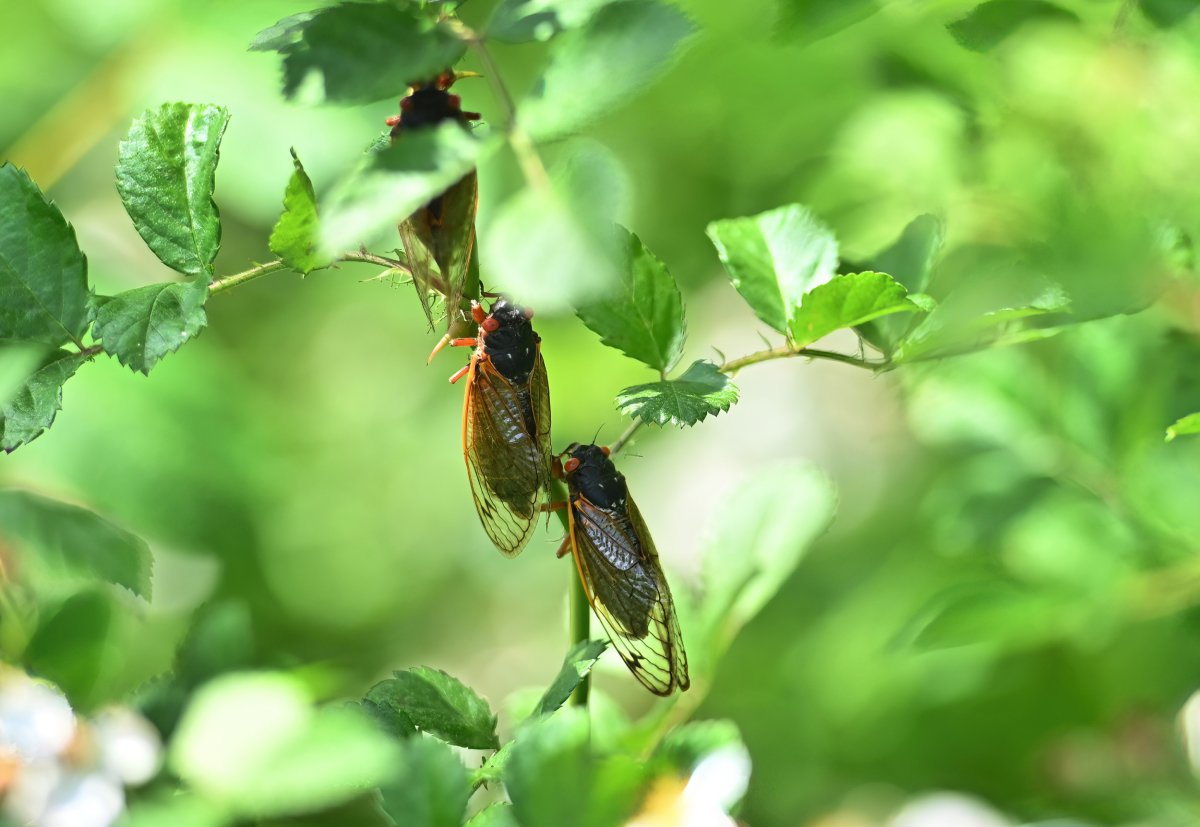Up to a trillion cicadas are expected to emerge across the United States this spring once the soil underground reaches the perfect temperature for them to come up, as the result of a rare double-brood event that hasn't happened in over two centuries.
While cicadas historically tend to appear in mid-May, in Missouri they might emerge screaming from the soil as soon as this week, as warm temperatures could lead them to wake up early from their long slumber.
Hunter Bassler, a journalist at St. Louis news broadcaster KSDK, wrote that the cicada's emergence might start on Tuesday, April 16, as suggested by three key factors: the temperature of the soil, holes appearing in the ground, and iris blossoms.
Two broods, or populations, which have been hibernating underground for over a decade—respectively 13 years and 17 years—will emerge from the ground in more than a dozen states across the Southeast and Midwest this spring. Brood XIX and Brood XIII have not emerged together in the U.S. since Thomas Jefferson was president in 1806; this won't happen again for another 221 years, until 2245.
Periodical cicadas have historically emerged when the soil temperatures at 8 inches below the surface reached 64 degrees, as found in a 1968 research study. According to data from the National Weather Service (NWS), soil temperatures across several areas of Missouri—including Gray Summit, Elsberry, and Prior—have already reached and passed 64 degrees.

Several areas in Iowa and Illinois, where cicadas are expected to emerge, have also reached temperatures over 60 degrees.
Bassler reported that Missouri residents have also been spotting pencil-size holes at the base of trees across the state—a clear sign that the cicadas are preparing to emerge. The Associated Press previously reported that the cicadas' boreholes have been spotted in the ground in Georgia, suggesting they're ready to come out of hibernation in the Peach State, too.
The blooming of irises, which tend to appear at the same time as the cicadas emerge from the ground, can also be a telltale sign that the time is near for the loud insect to cover fields and houses along their path. In Missouri, irises have begun to bloom as early as April 10, according to the Missouri Botanical Garden, as reported by Bassler.
Floyd W. Shockley, entomologist and collections manager at the Smithsonian National Museum of Natural History, told Newsweek that the cicadas won't give much warning of their emergence.
"They are waiting underground for the soil temperature 8-12 inches down to hit 64 degrees F. Once it does, they will begin burrowing to the surface," he said. "The only sign of an imminent emergence is the sudden appearance of their exit holes which they will dig all the way to the surface and will then wait until the following evening as they don't like to emerge during the day—to avoid predators as they are very vulnerable as nymphs and teneral adults."
According to Shockley, the first cicadas have already started emerging, but the bulk of it "will wait another week or two before they really get going."
"Because temperature is their trigger during an emergence year, they tend to start emerging in the southernmost distribution of the Brood and then sweep northward as the soil temps hit that threshold temperature," Schockley explained.
"Meaning, there will be periodical cicadas out in force beginning in a few weeks in the Deep South and then sweeping northward through May and into Early June. Then around that last week of May Brood XIII will start emerging and will be around for most of June. So, bottom line, there will periodical cicadas out from late April into early July, but not all at the same time. And not the same Brood," he added.
The two groups of cicadas, who have the common goal of mating, laying millions of eggs, and dying in a timeframe of about five weeks after they come to the surface, are expected to overlap in the states of Illinois and Indiana.
Brood XIX is expected to emerge in 14 states, including Alabama, Arkansas, Georgia, Illinois, Indiana, Kentucky, Louisiana, Mississippi, Missouri, North Carolina, Oklahoma, South Carolina, Tennessee and Virginia. Brood XII is expected to be spotted in Illinois, Indiana, Iowa and Wisconsin.
Newsweek published a complete map of where the cicadas will emerge here.
Update 4/18/24, 5:35 a.m. ET: This article was updated to add comment from expert Floyd Schockley.
Uncommon Knowledge
Newsweek is committed to challenging conventional wisdom and finding connections in the search for common ground.
Newsweek is committed to challenging conventional wisdom and finding connections in the search for common ground.
About the writer
Giulia Carbonaro is a Newsweek Reporter based in London, U.K. Her focus is on U.S. and European politics, global affairs ... Read more
To read how Newsweek uses AI as a newsroom tool, Click here.








